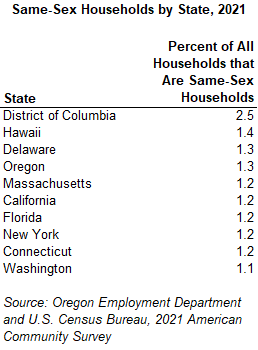Oregon Ties for Third Nationally in Share of Same-Sex Couple Households in 2021
September 12, 2023The American Community Survey administered by the United States Census Bureau made some changes in 2017 to the way they collected information from households; the changes were first implemented in the 2019 survey. The wording on the questions about who was living in a household revealed that many same-sex couples were being counted incorrectly. The changes made in relationship to householder and parent identification questions has allowed for better measurement of the specific type of family or living arrangement, especially for same-sex couples and their children. The Census Bureau has detailed findings about Same-Sex Couple Households within the selected topic Families and Living Arrangements.
Labor Force
In 2021, about 1,209,000 households in the United States were same-sex couple households; approximately 59% were married couples and about 41% were unmarried partner households. Among those households, there were more female-couple households than male-couple households in 2021. Same-sex married individuals ages 16 to 64 had a higher labor force participation rate at 84%, compared with their opposite-sex married peers at 80% in 2021. Same-sex married women had a participation rate of 83% compared with opposite-sex married women which was 71%. Men in opposite-sex relationships had a labor force participation rate of 89%, where same-sex married men had a participation rate of 85%. Same-sex married couples had a median household income of $103,000, while opposite-sex couples’ median household income was $102,800 in 2021.
Demographics and Children
Same-sex couples are typically younger than opposite-sex couples and are less likely to have at least one member eligible for retirement. In 2021, 25% of opposite-sex couples had at least one person 65 years or older, compared with 13% of same-sex couples. Same-sex couples are more likely than opposite-sex couples to be unmarried. However, the majority of couples are married, with married couples accounting for 59% of same-sex couples and 87% of opposite-sex couples.
Married couples are more likely to live with children under the age of 18, regardless of whether they are an opposite-sex or same-sex couple. Among same-sex married couples in 2021, about 18% had children under age 18, compared with 11% of unmarried same-sex couples. The American Community Survey also found that same-sex partners with children were more likely to be female. With opposite-sex couples, 38% of married couples have children under age 18, compared with 35% of unmarried couples.
People who were married had lower employment rates for both members of the household than people who were unmarried. Opposite-sex couples who were married were less likely to be employed, with both partners employed in 47% of households. In contrast, both partners were employed in 58% of married same-sex couple households.
Oregon
In Oregon, same-sex couples accounted for 1.3% of overall households. Married same-sex couples numbered an estimated 12,628 households or 0.7% of the overall households, and unmarried couples made up another 9,280 households which accounted for 0.6% of the state’s overall households. Of the same-sex couples in Oregon, 41.4% were male and 58.6% were female. In 2021, Oregon was tied for the third highest percentage of same-sex couple households in the United States at 1.3%.

Out of the same-sex married couples in Oregon, 20% have children under 18. Of the adults in same-sex couples, 23% have a bachelor’s degree and 26% have a graduate or professional degree. The average household income of opposite-sex partners in Oregon is $127,102, and same-sex couples have an average household income of $134,989.
The improvements that the Census Bureau has made over the past 10 years have resulted in a more accurate measurement of the households that contain same-sex couples. These improvements will allow further exploration of the characteristics of same-sex couples and the cities that they live in.